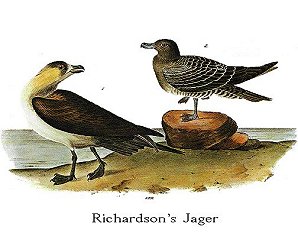
| Family XLIII. PROCELLARINAE. FULMARS. GENUS I. LESTRIS, Illiger. JAGER. |
Next >> |

Family |
RICHARDSON'S JAGER. [Parasitic Jaeger.] |
| Genus | LESTRIS RICHARDSONII, Swains. [Stercorarius parasiticus.] |
This bird, though rare on the coast of the United States, visits the shores
of Massachusetts and Maine, where, during winter, it is seen over the bays and
inlets, to which various species of Gulls also resort at the same season. It is
more shy and difficult to be approached than the Pomarine Jager. Its flight is
rapid and greatly protracted; and, like the other species of this genus, it
harasses the smaller Gulls and Terns, forcing them to disgorge their food. Dr.
RICHARDSON informs us that it breeds in considerable numbers in the barren
grounds, at a distance from the coast, and that it feeds on testaceous mollusca,
which are plentiful in the small lakes of the fur countries. I am unable to
afford any information respecting its habits; nor can I state decidedly the
number of eggs which it lays, although I have procured several of them. They
measure two inches and three-eighths in length, by one inch and five-eighths in
breadth, are of an oval rather pointed form, and have a dull greyish-yellow
ground, patched with umber and faint purple, the markings closer towards the
larger end.
LESTRIS RICHARDSONII, Richardson's Jager, Swains. and Rich. F. Bor. Amer.,vol. ii. p. 433.
RICHARDSON'S JAGER, Nutt. Man., vol. ii. p. 319.
RICHARDSON'S JAGER, Lestris Richardsonii, Aud. Orn. Biog., vol. iii.p. 503.
Male, 18 1/2, 40. Young, in September, 15 1/2; wing, 11 1/2.
Coast of Massachusetts and Maine, during winter. Breeds in the northern
barren grounds, away from the coast.
Adult Male in spring.
Bill about the length of the head, rather slender, straight, the tip
curved. Upper mandible with the dorsal line straight, toward the end curved,
the ridge broad and convex, the sides separated from the ridge by a narrow
groove, extremely narrow and convex, the edges sharp and inflected, the tip
compressed, rather obtuse. Nostrils in the fore part of the nasal groove,
nearer the tip than the base, sub-marginal, pervious, linear-oblong, wider
anteriorly. Lower mandible with the angle long and narrow, a slight prominence
at its extremity, beyond which the dorsal line is straight and ascending, the
sides sloping outwards and convex, the edges sharp and inflected, the tip
obliquely truncate and rather obtuse.
Head rather small, oblong, much narrowed before. Neck of moderate length.
Body rather slender. Feet rather short, and of moderate strength; tibia bare at
its lower part; tarsus anteriorly covered with broad decurved scutella, on the
sides with oblong scales, behind with smaller oblong prominent scales; hind toe
extremely small and elevated, the fore toes of moderate size, connected by
reticulated webs, which have their margins convex; the third toe longest, the
fourth a little shorter, the second considerably shorter; all covered above with
numerous scutella, the lateral ones margined externally with small prominent
scales directed forwards. Claws of moderate size, curved, acute, compressed,
that of third toe with a sharp inner edge.
The plumage in general is close, elastic, soft, and blended; the feathers
on the back and wings rather compact and distinct. Wings very long, rather
broad, pointed; primary quills tapering and rounded, the first longest, the rest
rapidly graduated; secondary rather short, obliquely rounded. Tail feathers of
moderate length, excepting the two middle, which extend beyond the rest and
taper to a point, the other feathers broad and rounded, there being twelve in
all.
Bill greyish-black, the upper part bluish. Iris brown. Legs and feet
black. The general colour of the plumage is of a sooty-brown, the upper part of
the head, the primary quills, and the tail darker, the breast and abdomen
lighter; the shafts of the primary quills white, of the tail feathers brownish.
Length to end of tail 18 1/2 inches, to end of wings 17; extent of wings
40; wing from flexure 12 3/4; tail 8 1/2, the middle feathers 2 3/4 longer than
the rest; bill along the back 1 4/12, along the edge of lower mandible 1 3/4;
tarsus 1 8/12; middle toe 1 5/12, its claw 4/12.
Young Bird in September.
Bill light blue, dusky at the end. Iris brown. Tarsi and basal portion of
the toes and webs light blue, the rest black. The general colour of the plumage
is sooty-brown, lighter on the neck and lower parts; the feathers of the back
are all tipped with whitish, and the breast, sides, lower wing-coverts, abdomen,
and lower tail-coverts, are undulatingly barred with pale greyish-yellow.
Length to end of tail 15 1/2 inches, to end of wings 13 1/2, to end of
claws 13 1/4; wing from flexure 11 1/2; tail 6 1/4, the middle feathers only 3/4
longer than the rest; bill along the back 1 1/4; tarsus 1 3/4; middle toe and
claw 1 1/2. Weight 7 oz.
| Next >> |